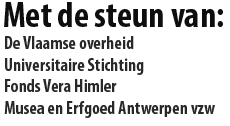A.K.L. THIJS
De Antwerpse Ommegang in 1599
Summary : The Antwerp “Ommegang” in 1599
On the basis of the acquittances of the Antwerp audit office, the author tries to reconstruct part of the Whitsun Ommegang (a historic and aristocratic pageant) of June 6th 1599.
An earlier hypothesis put forward by C. Leo Truyens (1884-1970) who thought that the Archdukes’ lacework was no Brussels product but an Antwerp one, is examined on the basis of the scarce archivalia.
In addition to this, the author shows interest in the Our Lady Ommegang of 22nd August 1599, that bore a resemblance to the Whitsun Ommegang, as for the composition that is.
The religious and secular elements in either “ommegang” are dealt with in this analysis. The amounts paid out to the participants tell us something more about the sociological aspect of the events.
,
J. THEUWISSEN
Een Hollandse dame, begijntje in Turnhout – Het angelusluiden
Summary : A Dutch lady, beguine in the town of Turnhout (province of Antwerp, Belgium)
The last beguine in the Turnhout beguinage range the angelus bell in a wrong way. The angelus is a devotional exercise said by Roman Catholics at morning, noon and sunset, at the call of the angelus-bell. The author
examines this kind of bell-ringing in the border region, i.c. in the nothern part of the Belgian provinces of Antwerp and Limburg, in the southern part of the Dutch province of North Brabant, and in the norhwest of the Belgian
province of East Flanders. He sent a questionnaire to the administration of the towns and villages situated in this research area and so learnt to know where angelus-ringing is still practised. He particularly studied the way the bell is rung and noticed that only in Turnhout the angelus is rung in a different way. In some 80% of the towns and villages sent a questionnaire to, the angelus bell is still rung despite of the fact that the devotional exercise
related to it that almost completely disappeared.
,
V. HAMERS
Een teken van vroomheid – Veld- en wegkapellen in het Zuid-Limburgse (NL) landschap
Summary : Tokens of Devoutness. Field and roadside chapels in the southern Limburg. Scenery of the Netherlands
This contribution originates from a Master’s thesis submitted to the Department of History of Art of Nijmegen Catholic University. The author concentrates on several aspects of the field and roadside chapel, such as its function, setting, motivation for building, architectural design and interior decoration. On the basis of these elements a typology of the chapel is drawn up. Also the saints invoked in these southern Limburg chapels are passed in review. The author of this article also compiled a field chapel guide entitled “‘T Kapelke… langs velden en wegen in Zuid-Limburg”, Eindhoven, 1999. (Chapels along fields and roads in Southern Limburg). The publishing of this guide is an initiative of “Stichting Cultura” (Cultura Foundation), an association aiming at giving special attention to the Dutch cultural heritage.
,
W.L. BRAEKMAN
Spotedict van de Brusselse vaartkapoenen en wens van de lichtekooien (1787)
Summary : Satirical edicts by the Brussels dockers of the canal and wish of Prostitutes
In times of political or social unrest, official promulgations such as decrees, edicts, ordinances, characterized by stereotyped laguage and rigid formalities were often imitated and ridiculed for political purposes or (and) for fun. The outward features of the official documents with all their trimmings are treserved and clash with the trifling content. Such ephemeral and strongly topical texts have very rarely come down to us. Two late 18th-century examples of lampoons from Brussels, the one by the dockers of the canal, the other by the town women of easy virtue, are discussed and documented here.
,

